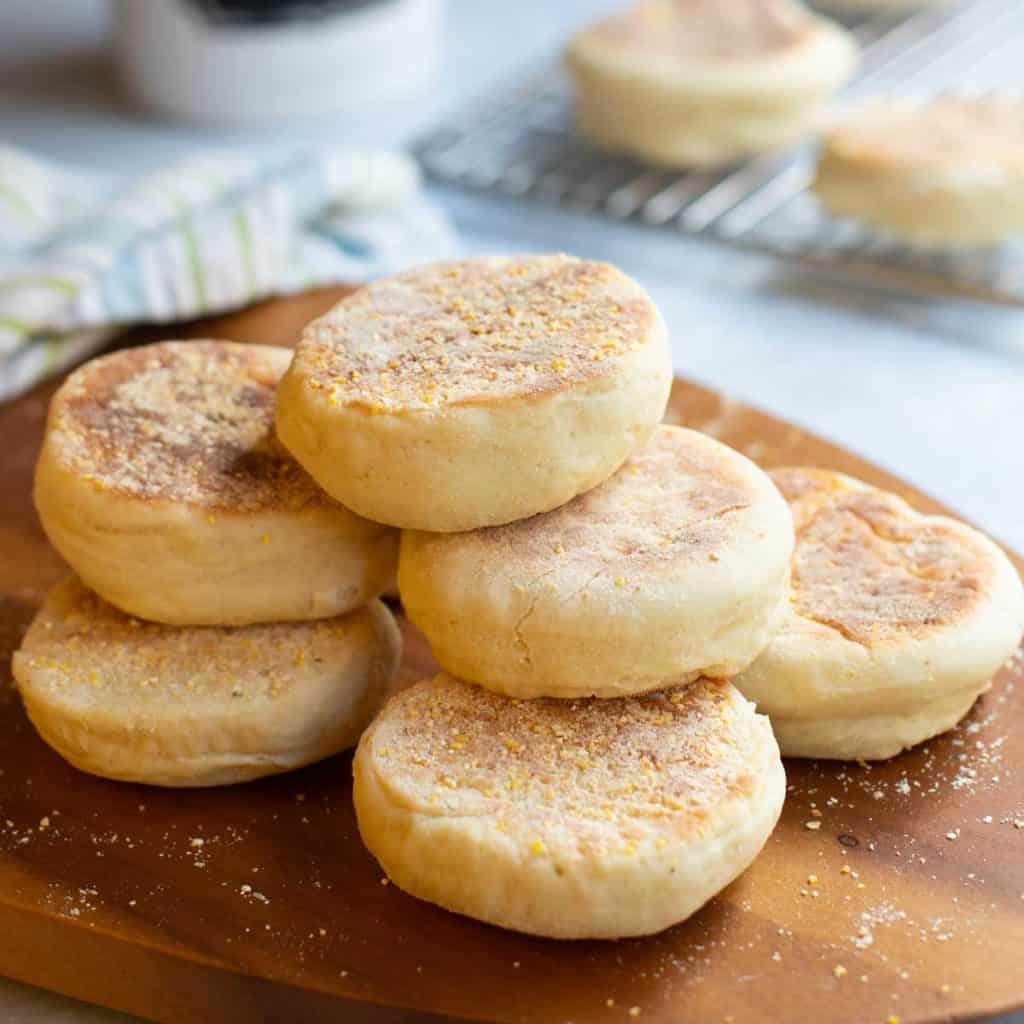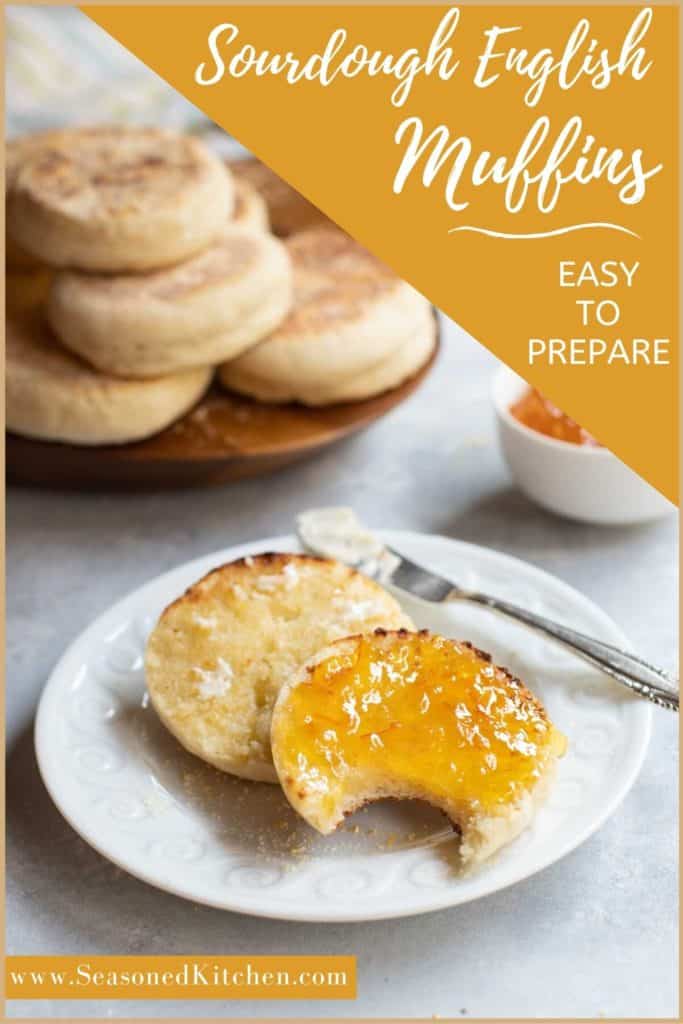Discover the joy of creating your very own Sourdough English Muffins at home and elevate your breakfast experience to new heights. These delectable treats offer a unique combination of sourdough’s signature tang and the classic chewy English muffin texture that will leave your taste buds singing with delight.
This post contains referral links for products I recommend. As an Amazon Associate, I earn a small commission on qualified purchases, at no cost to you.
I have loved English muffins since I was a little girl. Mom used to serve them several different ways – she would toast them up with butter and her homemade jam for breakfast, or even broil them with butter and Parmesan cheese for dinner. So, a few weeks ago at our neighborhood farmer’s market, I tasted a scrumptious egg sandwich on a homemade English muffin. And, the fellow in the booth said the muffins were super easy to make. Really? And they were so good!
King Arthur Sourdough English Muffins
After the market, I came home and started researching recipes. Not surprisingly, on my favorite bread/baking website, kingarthurflour.com, I found a sourdough English muffin recipe that seemed similar to how the fellow at the market made his muffins. [Sidebar: I find King Arthur’s recipes to be clear and well tested; plus, if you have a question, you can call them.] The best part: their recipe calls for a sourdough starter, and I love anything with sourdough. I have a starter that was originally created by my grandmother in 1933! My family almost lost it – but that’s another story, that you can read about in The Saga of the Sourdough Starter if you are interested.
What makes English muffins bread different?
English muffins are round, usually 3 to 4 inches in diameter, with a chewy texture. Inside, they are full of air pockets. They contain less flour and sugar than most breads, and are cooked on a griddle instead of the oven.
Sourdough-fed Homemade English Muffin Recipe

What You’ll Need for Sourdough English Muffins
Here are the ingredients you’ll need to make these delightful muffins:
- Sourdough starter, fed or unfed – fed and ripe will give you a more vigorous rise
- Active dry yeast
- Unbleached all-purpose flour
- Dry buttermilk powder or buttermilk blend
- Granulated sugar sugar
- Table salt
- Butter
- Cornmeal
How long before baking should I feed my sourdough starter?
For this recipe, you can use unfed or fed starter. If you want a more vigorous rise, then feed your starter the day before. Then it will have time to double in bulk. If you’re using unfed and store your starter in the refrigerator, make sure to let it sit at room temperature for around 30 minutes to 1 hour.

How to Make Sourdough English Muffins
And, here is the step by step instructions for making these delicious muffins:
- Combine dry ingredients.
In a medium mixing bowl, whisk together flour, dry buttermilk, salt and remaining sugar. Set aside. - Proof yeast.
In a small dish, combine sugar, water (105 – 110 degrees), and yeast. Set aside for 3 to 5 minutes, or until it turns bubbly. The bubbles confirm your yeast is active (called “proofing the yeast”). - Combine starter, butter, yeast, and water.
In a large bowl of an electric mixer, stir together the sourdough starter, softened butter, proofed yeast, and remaining 3/4 cup of warm water (110 – 115 degrees). - Add dry ingredients.
Using a dough hook and keeping the machine on speed 2, add dry ingredients and beat for around 2 to 3 minutes, or until dough clings to the hook and cleans the sides of the bowl. - Knead dough; let rise.
Remove dough from the bowl and turn out onto a lightly floured surface. Knead a few times by hand until the dough is smooth and elastic, and feels like your earlobe or a baby’s bottom. Transfer dough to a large greased bowl, turning once to coat the surface. Cover with a clean dish towel and let rise in a warm place (85 degrees) for about 1 1/2 hours, or until it’s puffy and doubled in size. - Cut out rounds.
Sprinkle a large (half-sheet) rimmed baking sheet with cornmeal. Gently punch down dough, turn it out onto a lightly floured work surface, cover it, and let it sit for a few minutes. Roll 1/2-inch thick, cut into 3-inch rounds and place, evenly spaced, on the prepared pan. Re-roll and cut any remaining scraps to get 12 rounds. - Let rise.
Sprinkle cornmeal on top of muffins, cover with plastic wrap (no need to grease), and let them rise until light and puffy, about 45 to 60 minutes. - Prep griddle.
Preheat an electric griddle to 350 degrees (note: if your griddle is black, preheat to 310 degrees). Alternatively, heat an ungreased skillet over medium-low heat. - Cook muffins on one side.
Carefully transfer the muffins right-side-up to preheated griddle/skillet – make sure they aren’t touching each other. Cook for about 5 minutes, then place a smallish cookie sheet on top (can also use a light baking dish). Continue for an additional 5 to 7 minutes, or until muffin bottoms are a golden brown color. - Flip muffins.
Remove cookie sheet, flip muffins over, and continue cooking (without cookie sheet) for an additional 10 to 12 minutes, until golden brown on the second side and an instant-read thermometer inserted in the center of a muffin registers 190 degrees. - Remove and cool.
Remove muffins from the griddle, and cool on a rack.
Sourdough English Muffin Recipe Storage
Cooked muffins can be stored in a sealed container (like a ziptop baggie) at room temperature or in the refrigerator for up to 4 days.
Do sourdough English muffins need to be refrigerated?
No, English muffins don’t need to be refrigerated if they are consumed within 4 days of baking.
How long are English muffins good for?
Sourdough English muffins will last 4 days stored in a sealed container at room temperature or in the refrigerator. They will last 3 months if frozen.
Can you freeze English muffins?
Yes, you can freeze these muffins for up to 3 months.
How to freeze
Place English muffins in an airtight container (a freezer ziptop baggie works well) and they will keep in the freezer for up to 3 months.

How to Eat an English Muffin (Sourdough)
I like serve these English muffins in a variety of ways. First, they are a perfect base for these breakfast delights:
Alternatively, they are just as good served:
- toasted, then covered with butter and jam (as my mom used to do), or
- slathered with butter, sprinkled with Parmesan cheese and garlic salt, and toasted until under the broiler until the cheese melts (great with any pasta dish!).
How to Toast English Muffins in the Oven
If you don’t own a toaster or toaster oven, here’s how you can toast English muffins in the oven:
- Move oven rack to top rack and preheat oven broiler.
- Place split muffins on a cookie sheet and place under broiler until top is browned, 1 1/2 to 2 minutes. Watch carefully as they can cook quickly!
- Using kitchen tongs, turn muffins over and toast other side for 1 1/2 to 2 minutes.
Option: slather the cut side of the muffins with butter, and toast only that side under the broiler.

English Muffin Sourdough Recipe
Discover the joy of creating your very own Sourdough English Muffins at home and elevate your breakfast experience to new heights. These delectable treats offer a unique combination of sourdough’s signature tang and the classic chewy English muffin texture that will leave your taste buds singing with delight. These muffins are delicious toasted with butter and jam, as mom used to do, or as part of an egg sandwich, or with Eggs Benedict with Easy Blender Hollandaise Sauce!
- Prep Time: 20 mins
- Rise time: 145 mins
- Cook Time: 20 mins
- Total Time: 3 hours 5 minutes
- Yield: One dozen
- Diet: Vegetarian
Ingredients
- 1 tablespoon sugar, divided
- 1 cup warm water, divided
- 1 1/2 teaspoons active dry yeast
- 3 1/8 cups (just shy of 15 ounces) unbleached all-purpose flour – see Note
- 1/4 cup dry buttermilk (or nonfat milk), fluffed with a fork (see Note)
- 1 1/2 teaspoons table salt
- 1/2 cup sourdough starter, fed or unfed; fed and ripe (doubled in size) will give you a more vigorous rise
- 2 tablespoons butter, at room temperature
- cornmeal, for coating
Instructions
- In a medium mixing bowl, whisk together the flour, dry buttermilk, salt and remaining 2 3/4 teaspoons sugar. Set aside.
- In a small dish, combine 1/4 teaspoon sugar, 1/4 cup water (105 – 110 degrees) and yeast. Set aside for 3 to 5 minutes or until it turns bubbly. The bubbles confirm your yeast is active (called “proofing the yeast”).
- In a large bowl of an electric mixer, stir together the sourdough starter, softened butter, proofed yeast, and remaining 3/4 cup warm water (110 – 115 degrees).
- Using a dough hook and keeping machine on speed 2, add dry ingredients and beat for around 2 to 3 minutes, or until dough clings to the hook and cleans sides of the bowl.
- Remove dough from the bowl and turn out onto a lightly floured surface. Knead a few times by hand until the dough is smooth and elastic, and feels like your earlobe or a baby’s bottom. Transfer dough to a large greased bowl, turning once to coat the surface. Cover with a clean dish towel and let rise in a warm place (85 degrees) for about 1 1/2 hours, or until it’s puffy and doubled in size.
- Sprinkle a large (half-sheet) rimmed baking sheet with cornmeal.
- Gently punch down dough, turn it out onto a lightly floured work surface, cover it, and let it sit for a few minutes. Roll 1/2-inch thick, cut into 3-inch rounds and place, evenly spaced, on the prepared pan. Re-roll and cut any remaining scraps to get 12 rounds.
- Sprinkle cornmeal on top of muffins, cover with plastic wrap (no need to grease), and let them rise until light and puffy, about 45 to 60 minutes.
- Preheat an electric griddle to 350 degrees (note: if your griddle is black, preheat to 310 degrees). Alternatively, heat an ungreased skillet over medium-low heat.
- Carefully transfer the muffins right-side up to preheated griddle/skillet – make sure they aren’t touching each other. Cook for about 5 minutes, then place a smallish cookie sheet on top (can also use a light baking dish). Continue for an additional 5 to 7 minutes, or until muffin bottoms are a golden brown color.
- Remove cookie sheet, flip muffins over, and continue cooking (without cookie sheet) for an additional 10 to 12 minutes, until golden brown on second side and an instant-read thermometer inserted in the center of a muffin registers 190 degrees.
- Remove muffins from the griddle, and cool on a rack. Store in a zip top baggie at room temperature up to 4 days; can also be frozen.
Notes
Note on dry buttermilk: Buttermilk powder (or buttermilk blend) can be found in major grocery stores or specialty stores, usually in the baking aisle. It is also available online.
Note on flour for high altitude: Above 7500 feet, reduce flour to 3 cups, or around 14. 5 ounces.
- Category: bread, baking, breakfast and brunch, side dishes
- Method: Baking
- Cuisine: American
Sourdough English Muffins FAQs
Sourdough English muffins are made using a sourdough starter, which gives them a tangy flavor and a unique texture. They have a chewy interior with a slightly crispy exterior, making them stand out from regular English muffins.
You have the option to use either store-bought or homemade sourdough starter for these muffins. Store-bought starters are convenient and time-saving, while making your own gives you more control over fermentation and flavor. If you prefer to make your own starter, a helpful approach is to ask a friend who has an active starter if they can provide you with some of their discard. By feeding it, you can maintain and have a steady supply of starter available for various recipes.
There are several possible reasons why your English muffins came out too dense:
1. Didn’t knead long enough. Gluten provides structure and helps trap air bubbles during fermentation (rising time), contributing to a light and airy texture. Not enough kneading can cause insufficient gluten development.
2. Not enough rise time. The fermentation that occurs when the dough is rising is key to the texture. Make sure to allow it to rise the recommended amount of time.
3. Too much rise time. If the dough is left to rise for too long, the gluten structure may weaken, causing the muffins to collapse during baking.
4. Too much flour. The ratio of flour to liquid in the dough affects the texture. If the dough is too dry and stiff, it can lead to denser results.





